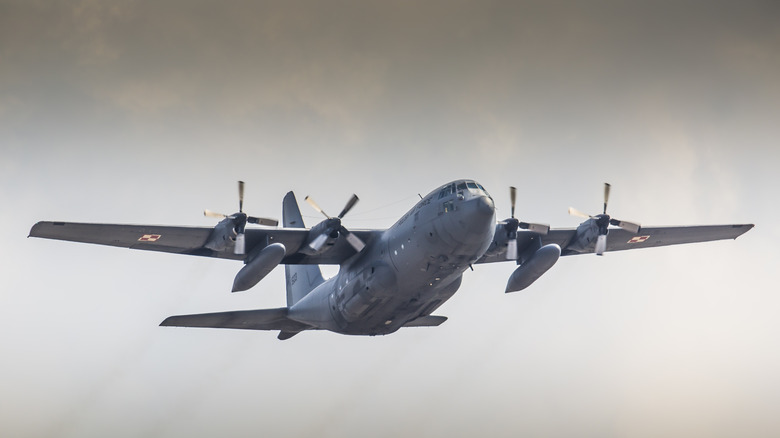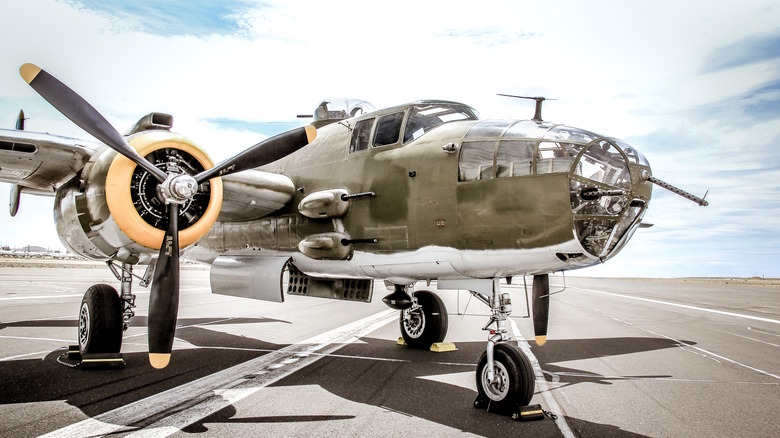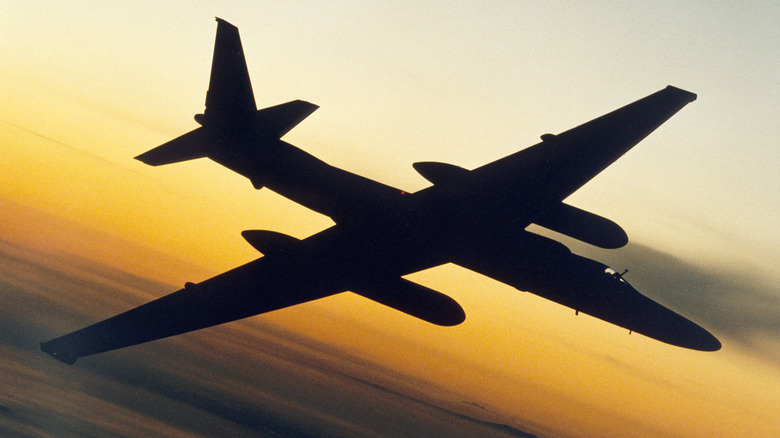4 Unexpected Planes That Landed On An Aircraft Carrier
Flying an airplane is a challenging skill on its own. Civilians need over 40 hours of flight training to receive their pilot license, while military pilots require exceptionally more training. But flying is only a third of the pilot's job, and pilots also have to handle taking off and landing. While taking off might be considered a pilot's easiest responsibility, landing is a little more tricky. It requires lowering the landing gear, angling the plane's nose to a specific degree, extending the flaps, accounting for crosswinds, decreasing air speed, and so many other factors. Now consider accomplishing that tricky landing on a moving object with a shorter runway.
Because of these challenges, planes that are allowed to land on aircraft carriers need to meet certain specifications, such as having reinforced landing gears, an arresting hook, wings that fold to accommodate for other aircraft on the carrier, and an airframe that can withstand the stress of catapult launches. However, just as there are some unexpected jobs found on an aircraft carrier, there have been some planes that have unexpectedly found themselves on a carrier.
Whether because the Navy wanted to test a new plane for its arsenal or circumstances required the use of an unlikely plane, every so often, a plane not designed for carrier landings might find itself aboard these floating cities. History has some rather fascinating records of such events.
C-130 Hercules was the biggest plane to land on a carrier
The largest plane to ever land on an aircraft carrier was the C-130 Hercules, a cargo plane primarily used by the United States Air Force (USAF). However, this massive plane almost never lands on aircraft carriers because of its size. Reportedly, the pilot, Lt. James H. Flatley III, didn't even believe the plan when he was assigned to it.
The U.S. Navy typically uses smaller planes known as carrier onboard delivery (COD) aircraft that can easily land on carriers. The problem was that using smaller planes like the C-1 Trader, which has a range of only 300 miles, meant an onboard delivery wasn't possible when a carrier was in the middle of an ocean. So, the U.S. Navy came up with the idea to test land the Hercules on a carrier in 1963 to serve as a type of "Super COD."
The Navy chose the USS Forrestal (CVA-59) as the test site 500 miles off the coast of Boston. The Hercules' wings barely cleared the carrier's control tower, swooping in with fewer than 15 feet to spare. In the end, they successfully executed 29 touch-and-go landings, 21 unarrested full-stops, and 21 unassisted takeoffs with the maximum gross weight ranging from 85,000 pounds up to 121,000 pounds. Overall, the Navy deemed the test successful but too risky to rely on as a standard practice.
The U.S. Navy launched a squad of B-25 bombers from a carrier after Pearl Harbor
After the Japanese ambushed Pearl Harbor on December 7, 1941, the U.S. wanted to launch a counter offensive as soon as humanly possible. By February 1942, the USAF was planning to launch a squadron of B-25 bombers from an aircraft carrier. Based on its size, the powers-that-be determined the B-25 could be launched from a carrier, but they needed to test it. This originally included three B-25s taking off from the USS Hornet (CV-8), but one of the bombers suffered from engine issues that couldn't be repaired in a timely manner, so only two of the bombers made it onto the Hornet for the test.
The test out at sea was successful, allowing the U.S. to move forward with its counter attack. Before the planes could launch, most of their machine guns had to be removed to accommodate for more fuel, which made it easier to take off from a short runway. On April 18, 1942, five months after the attack on Pearl Harbor, Lt. Col. "Jimmy" Doolittle led 15 B-25 Mitchell bombers on a bombing raid across the mainland of Japan.
This was not the last time the U.S. would launch a B-25 from a carrier. The bomber underwent several modifications to make it more suitable for carrier missions and on November 15, 1944, the first carrier landing with a B-25 bomber was made.
A Vietnamese man landed on an aircraft carrier in an evacuation
This next aircraft wasn't a test of ingenuity. It was simply a desperate attempt made by a frantic man trying to save his family. Saigon, otherwise known as Ho Chi Minh City, had to be evacuated in 1975 when the North Vietnamese army invaded. A Major in the South Vietnamese Air Force named Bung-Ly needed to escape and took desperate measures to save his family.
He flew himself, his wife, and five children in a Cessna 0-1 Bird Dog, which is supposed to only seat a pilot and one other passenger. They took off from Con Son Island and needed to find somewhere safe to land fast because the plane only had enough fuel to stay in the air for an hour. Bung-Ly eventually found the USS Midway (CVA-41). Whether it was because the Cessna's radio didn't work or he couldn't get a hold of the carrier, Bung-Ly or his wife handwrote a letter making his intentions to land clear and dropped it to the carrier's flight deck. The letter miraculously made it aboard and subsequently into the Commanding Officer's hands.
He approved the landing, but there were a couple problems: The small Cessna wasn't designed for a carrier landing — it didn't even have a tail hook — and there wasn't enough space for it to land. The CO did the unexpected and ordered $10 million worth of aircraft be pushed overboard. Bung-Ly and his family made it aboard safely.
The CIA landed a U-2 spy plane on a carrier
The USAF keeps flying the U-2 Dragon Lady, and there is a reason for that. First of all, it has a range of more than 7,000 miles and a maximum cruising altitude of 70,000 feet. However, it couldn't reach every destination the CIA wanted to surveil, so they eventually came up with the idea to make this plane carrier-capable. The U.S. government has to negotiate an agreement whenever it wants to establish a base in an allied country, which could become tense and time-consuming. The idea was to modify U-2s for carrier operations to expand their range.
The Navy was excited for such a plan, but the Air Force had no desire to participate. Nonetheless, the Navy forged ahead in partnership with the CIA with Project Whale Tale. From the USS Kitty Hawk (CV-63), a U-2 "Dragon Lady" successfully took off without any catapult assistance off the coast of San Diego, California. Unfortunately, its landing was... a learning experience.
The U-2 bounced and damaged one of the wings, which is where the CIA and Navy realized some modifications were necessary. After adding reinforced landing gears, a tail hook, wing spoilers, and folding wings, the first landing without incident happened in March 1964. After only one real operational mission, the Navy and CIA opted to not carry on with the project due to space-based reconnaissance improvements that made it unnecessary.




